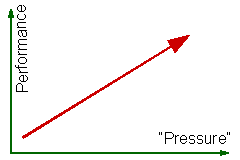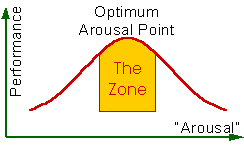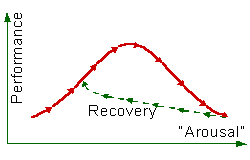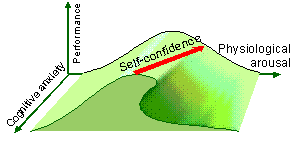| Understanding arousal/performance relationships |
|
|
| Four models of the effects of arousal - physical or
mental - on performance have similar implications.
They're certainly oversimplified, and none is 'quantitative'. I've
put them here for two reasons. First, they show how understanding
of arousal and performance is developing, and also increasngly recognising
the complexity of the problem. Second, the pictorial representation
can be useful in talking about the practical effects of arousal; for
example, "The Zone" is a description arising from the second
of these pictures. |
 Drive
theory Drive
theory |
 |
| Drive theory simply says "More pressure
gives greater performance". True to a point... for
example, with no pressure at all, you don't perform at
all. Or get out of bed, for that matter |
|
 Inverted-U Inverted-U
|
 |
| The "Inverted U"
hypothesis (Note 1) starts
like drive theory, but predicts a point where increasing
arousal decreases performance. That sounds more
familiar - and it certainly happens that way in endurance
events. |
|
 Hysteresis Hysteresis
|
 |
| The hysteresis model recognises
that in many cases, following a ‘crash’ one has to reduce
arousal substantially before performance starts to recover
much. That's a pretty good description for physiological
arousal, but maybe not so good for 'anxiety'. |
|
 Multidimensional
models Multidimensional
models |
 |
| Multidimensional models recognise many
components to ‘arousal’; a physiological component (heart
rate etc.), a ‘cognitive’ component (nervousness, fear
of failure or consequences of failure), and further factors
which reduce or increase the problem. The one above (Note
2) suggests that as anxiety ("cognitive anxiety")
increases, 'falling off a cliff' is more likely, but confidence
acts to reduce the effect. |
|
|
|
 Implications Implications |
|
|
 |
SOME arousal is essential for good performance |
These two add up to something important.
Somewhere, there is a Zone where performance is best - an optimum
arousal level, or optimum arousal point. Finding that Zone is
the main aim of arousal control. |
 |
Too much arousal is bad for performance |
 |
Recovering from a ‘crash’ is possible but often
slow |
|
 |
Many different factors affect 'arousal' |
|
Note 1. I'm reminded
that this was first described by Yerkes and Dodson in the 1920's!
Note 2. This particular
picture is based on a model suggested by Fazey and Hardy, in 1988,
which attempts to account for the observation that in some circumstances,
performance follows the inverted U scheme and degrades smoothly
with increasing arousal, but in others, the decline is sudden and
steep. They suggested that the transition from smooth to catastrophic
behaviour was related to cognitive anxiety. The model is sometimes
referred to as 'catastrophe theory' (though I suspect that's more
because the phrase was trendy then than because it's got much to
do with the mathematical concept of catastrophe theory ;o) ) and,
like everything that fits in one paragraph, I've oversimplified
the implications.

|
|



